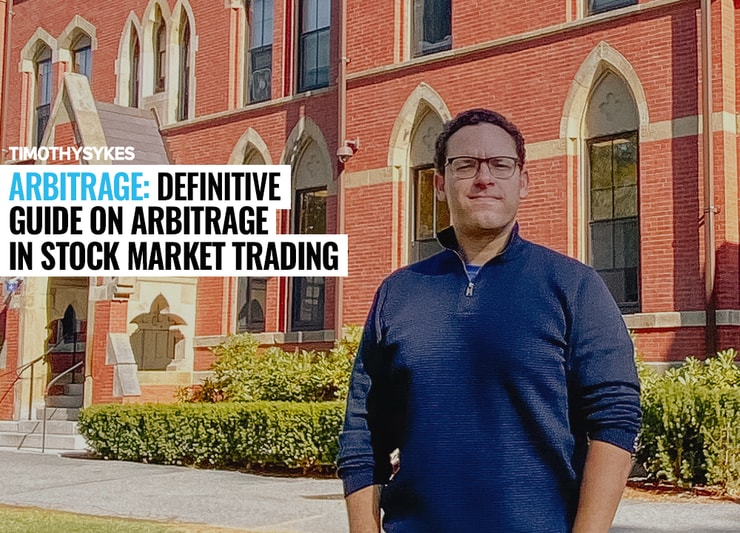Arbitrage isn’t an investment strategy you should take lightly. In fact, I’m not a fan of using it at all.
In most cases, only large investment firms and hedge funds can take advantage of arbitrage. It’s a strategy that requires a ton of money to be successful, so most individual investors don’t have the cash — or the stomach — for it.
Essentially, though, just like other stock market terms, arbitrage is just a name for a tactic traders use to maximize profits.
I’ll walk you through the definition of arbitrage and how some traders use it successfully. However, I want to warn you up front that arbitrage is not without risk. In fact, it’s one of the least reliable plays you can make — and if you do use it, your trading fees can quickly swallow your profits.
Since I believe that everyone should have a basic understanding of all stock market terms, though, I’m going to give you the rundown.
Table of Contents
What Is Arbitrage?

2025 Millionaire Media, LLCLet’s boil arbitrage down to its simplest parts …
In an arbitrage play, you buy something from one exchange or venue and sell it to another for a profit based on differences in the market price.
Before we jump into the stock market, let’s consider a simpler example.
For example: Let’s say you’re browsing a used bookstore. You find a first-edition copy of a highly sought-after book stuffed in the clearance section, so you buy it for a couple bucks. Then you go to eBay and list it for $120. If someone buys it at the list price, you pocket $118.
That’s arbitrage. It’s about leveraging differences in market prices to profit.
In the stock market, you might buy shares of a stock on one exchange and sell it on another. If a stock is trading for U.S.10 on a U.S. stock exchange and U.S.8 on a foreign stock exchange, you could purchase it for $8 per share and sell it for $10 per share.
That sounds like a great deal, but it doesn’t happen often — and when it does, the difference between market prices are generally just pennies. Consequently, what you pay in transaction fees will likely outweigh any profits you make.
Additionally, arbitrage opportunities typically only last for a few seconds. Today’s technology prevents most arbitrage plays from becoming a possibility, except for major firms that track stocks in real time.
Arbitrage Economics Definition
In economics, arbitrage is defined as the simultaneous buying and selling of the same securities or other financial instruments to profit from market variations. Buying the investment and selling it in the future introduces risk to the transaction and is therefore not considered arbitrage.
For simultaneous buying and selling, you need an electronic mechanism. Otherwise, it’s almost impossible.
In fact, it is impossible because of leg risk. Since you can’t sell what you don’t have, there are two legs to an arbitrage transaction: the buying and selling of the financial instrument. Although they might only be microseconds apart, price fluctuations can occur.
This is called leg risk or execution risk. That’s why people who say that arbitrage is risk-free are either unaware of the potential dangers or choose not to disclose them.
Arbitrage in Stock Market Trading
In the stock market, arbitrage specifically refers to buying stocks or derivatives in one market and selling them simultaneously in another for a profit. As I mentioned before, though, it’s generally impractical.
I’ve never found success with arbitrage. It’s far too complex, in my opinion. For one thing, you must have the information necessary to determine price variations between markets. For another, you need a way to capitalize on that information by simultaneously executing trades.
How Can You Profit from Arbitrage Opportunities?

2025 Millionaire Media, LLCSome of the top Wall Street traders use it frequently. They have extremely expensive databases and software programs that find the opportunities for them — and, in some cases, execute the trades automatically.
If you’re sitting in your home office and learning how to trade penny stocks, you probably don’t have those kinds of assets. That’s okay. Neither do I.
When it comes to stock trading, I like to keep things simple. I pay attention to stock charts, read up on companies that I believe might experience price movement, and execute trades based on my educated opinion. There’s no reason to throw a wrench into that winning formula and risk my money on an arbitrage play.
Those who profit from arbitrage often work on Wall Street and have access to serious computing power.
How to Develop an Arbitrage Strategy
A pure arbitrage play doesn’t have any risk. Unfortunately, pure arbitrage opportunities don’t present themselves very often.
In a perfect execution, you buy a security with one hand and sell it with the other. We already talked about leg risk, but if you have a setup where you can sell what you don’t have, there’s no inherent risk. You know the market price in both exchanges, so you’re guaranteed to make money.
Every opportunity hinges on price inefficiency. In other words, one exchange is slow on the uptake when it comes to a security’s market value.
Hedge funds and traders that use arbitrage frequently seek small, low-risk returns. In other words, they’re not raking in millions every day for their customers or for themselves because modern technology prevents serious price inefficiencies.
Back to my story about buying a rare book in a bookstore and selling it for a huge profit on eBay. It could be considered arbitrage if you listed the book at the same time you bought it, though there would be a delay in selling it and collecting the fee.
Arbitrage can happen in those two environments because they’re completely separate. The bookstore doesn’t automatically know what eBay buyers will pay for the book, and eBay doesn’t care what the store sells the book for.
On securities exchanges, however, price variations are far narrower when they happen at all because everyone knows what everyone else is doing. One exchange might be a few minutes or hours behind another, but it’s rare.
Arbitrage Possibilities and Opportunities
The biggest arbitrage opportunity lies in trading software. If you have powerful enough software, you can use it to detect minute variations in securities’ prices and capitalize on them.
However, it’s going to cost you.
Automatic, trade-alert, and remote-alert software programs can set you back thousands of dollars. Furthermore, they’re not as powerful as the commercial-grade software used by big hedge funds and investment banks.
These software programs detect small fluctuations in price that last just a few seconds. They execute the trades automatically based on preset criteria so the trader doesn’t have to run manual calculations.
Without some sort of automatic software, it’s nearly impossible to capitalize on stock market arbitrage. The opportunities don’t last long enough.
More Breaking News
- Senti Biosciences Stock Faces Decline Amid Market Challenges
- CLSK Shares Plummet: Is It Time To Exit?
- Unusual Machines Insider Trades $250,000 in Stocks Amid Market Fluctuations
Learn to Hone Your Skills with Professional Assistance
Traders sometimes “box” positions, which means that they take a long and a short at the same time. That’s arbitrage.
For instance, if its merger arbitrage, you might bet that the merger will benefit one company more and hurt the other, and that the prices will eventually reflect it in the stocks’ prices.
Going long and short in a merger arbitrage play might seem like a smart idea, especially if there’s been lots of fundamental information about the merger. But that means everyone else has the same information.
My advice: steer clear. Instead, consider sticking with my simple, more retail trader-friendly patterns that all the fancy, high-end computers don’t care about.
The multi-billion-dollar investment companies have endless amounts of computer data and pricey research that normal people like us don’t have access to. I prefer to play a game I can win.
Why Enroll Yourself in the Trading Challenge?
If you want to participate in the stock market and learn to avoid massive risk, apply to join my Trading Challenge. It’s a group of dedicated, hard-working traders who each have individual goals. We all, however, want to succeed in the stock market.
Several of my students have become millionaires, while others find themselves content with more modest incomes. You don’t have to shoot for the seven-figure stars to take advantage of the Trading Challenge.
Maybe you’re looking for a way to make some extra money so you can pay off old debt, or perhaps you want to send your kids to college so they don’t graduate under the burden of student loan debt.
Picture your goal, your dream, or your ideal lifestyle. It shouldn’t have a number in front of it. I got where I am today by visualizing my goals and working toward them. I’d like to help you do the same.
Types of Arbitrage

2025 Millionaire Media, LLCThough I’m opposed to using arbitrage, you can still familiarize yourself with the concept so you’re aware it exists. I’m all for education, so let’s look at a few distinct types of arbitrage and how they play out in the market.
Financial Arbitrage
In most cases, financial arbitrage refers to FOREX trading — foreign exchange trading, for the uninitiated. FOREX arbitrage occurs when you go long and short simultaneously on the exchange rates between two currencies.
Essentially, you see that the exchange rate is different between two separate exchanges. By buying on one and selling on the other, you profit.
Statistical Arbitrage
I won’t try to explain the mathematics behind statistical arbitrage (aka StatArb) because it’s too complex and far outside the scope of this article. Just know that it’s similar to pairs trading, but on a much bigger scale.
Those who participate in StatArb find hundreds or even thousands of stocks that are expected to move in statistically similar ways, but in opposite directions. Using complex trading software, they capitalize on those price movements by buying long and short positions, depending on the specific security.
Dividend Arbitrage
Dividend arbitrage involves buying a certain amount of stock, then buying put options on the same amount of stock. This occurs prior to the ex-dividend date. After the trader collects the dividends, he or she exercises the put option.
It’s a hedging strategy that requires dense mathematical formulas and expertise in options trading.
Tax Arbitrage
One of the best examples of tax arbitrage is trading in cryptocurrency. In the United States, capital gains from crypto trades are taxed. In other words, you have to pay the government a portion of your profits.
That’s not so in other countries — so-called “crypto tax havens” — like Denmark and Germany.
For example: You could buy crypto coins in the United States, then sell them in a tax-exempt country. As long as you profit from the trade, you’d make more money than you would by selling on a U.S. exchange because you wouldn’t have to pay taxes.
Uncovered Interest Arbitrage
This is perhaps the riskiest form of arbitrage because it assumes you can correctly guess the future spot exchange rate in a particular country. The idea behind uncovered interest arbitrage, which uses no hedging, involves exchanging one currency for another that has a higher deposit interest rate. That money is then invested abroad at the higher interest rate to profit.
Examples of Arbitrage
Believe it or not, arbitrage happens all around us.
If you spot a valuable record at a garage sale, buy it for a buck, and sell it for $200 to a collector, you’re participating in a form of arbitrage.
The same is true of a company that wants to reduce its labor costs. It moves part or all of its business to a foreign country with lower wage expectations. This is called global labor arbitrage — or, in more simplistic terms, offshoring.
It even happens in advertising.
Let’s say you have a website where you’ve posted a ton of content. You’re getting lots of clicks from Google search results, so you run tons of ads on every page.
You then take out ads on search engines or social media to drive traffic to your site. You’ll pay less for the clicks on your own ads than you’ll make from ads you show viewers who visit your site.
Arbitrage Profit Formula
There are several different profit formulas you can use, but they don’t always work out the way you expect. As I mentioned earlier, there are certain forms of risks with arbitrage, including leg risk, and securities often prove unpredictable.
Just to show you how complicated it can get, take the formula investor Benjamin Graham uses to calculate the risk/reward probabilities of an arbitrage situation.
Annual Return= CG-L(100%-C)/YP
In this formula, C represents the percentage chance of success, G represents the expected gain upon success, L is the anticipated loss, Y is the holding time in years, and P is the security’s current price.
See what I mean? Complicated.
Frequently Asked Questions
I often get the next two questions when my students ask me about this subject:
Is Arbitrage Legal?
There’s nothing illegal about it. That is, as long as you’re not violating any SEC rules or using underhanded tactics that could land you in jail.
Don’t ever do that.
Not only is arbitrage legal, but it can also be helpful for overall market health. It identifies inefficiencies in a market and brings them back into alignment.
What Is Regulatory Arbitrage?
Think of regulatory arbitrage as the practice of exploiting loopholes in business. For example, if you know you’ll pay a lower tax rate in state than in another, you might incorporate in the favorable state.
Companies use tax havens and other regulatory loopholes to reduce their expenses. It happens daily. Most of it is perfectly legal, but you need a professional to tell you whether you’re following the law.
The Bottom Line
While I’m not a fan of this strategy, that doesn’t mean it’s pointless. Many of the top Wall Street traders use it frequently to maximize profits, but they’re trading millions of dollars at a time.
There’s a reason it’s beneficial for them. They have more money and better computers.
I prefer to trade in the stock market using retail-friendly strategies. My gains might not be as big as those of the major Wall Street players, but I’m comfortable with how I generate profits.
If you want to learn from me and my most successful students, apply for the Trading Challenge. I’m excited to help you pursue your dreams.










Leave a reply